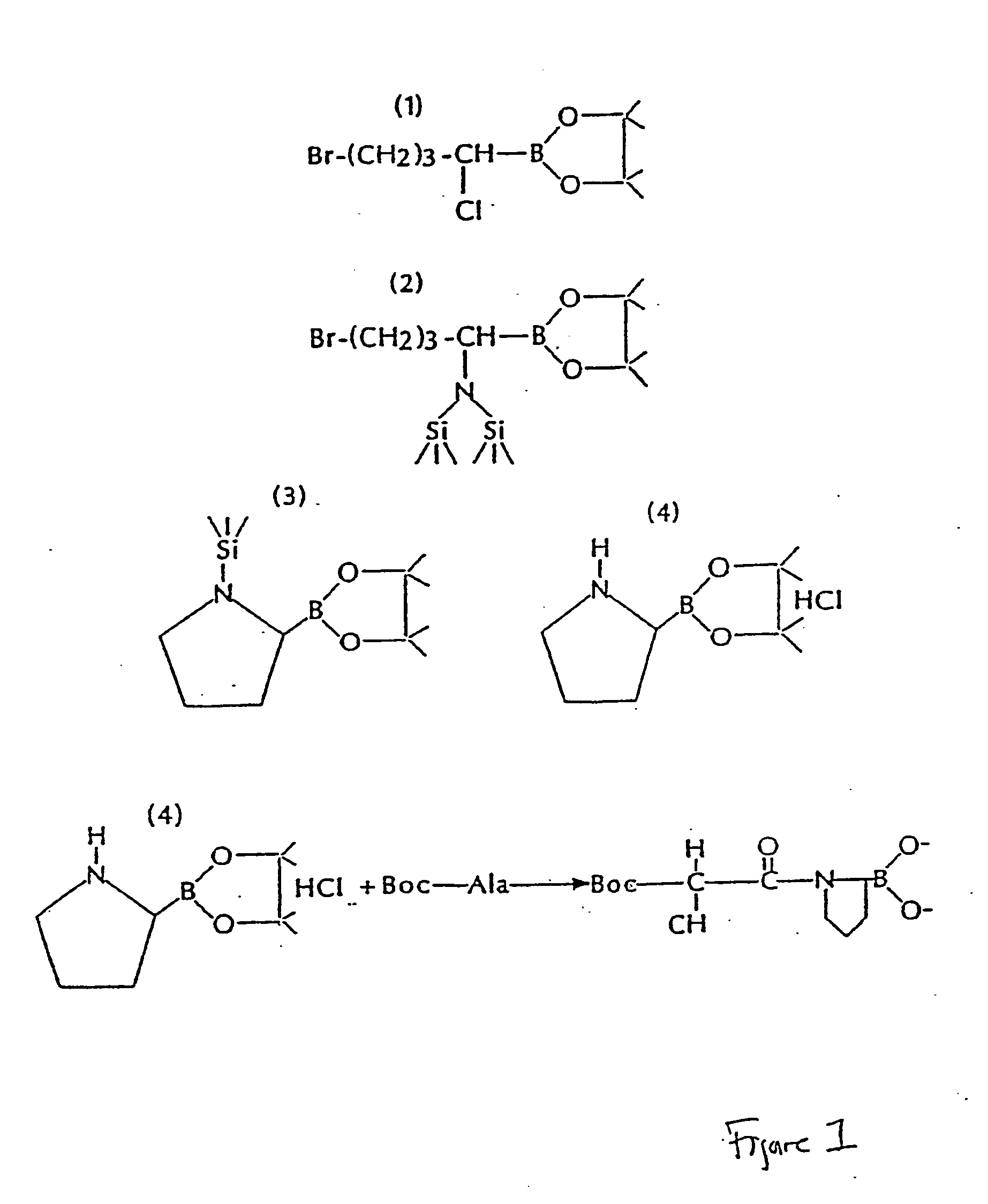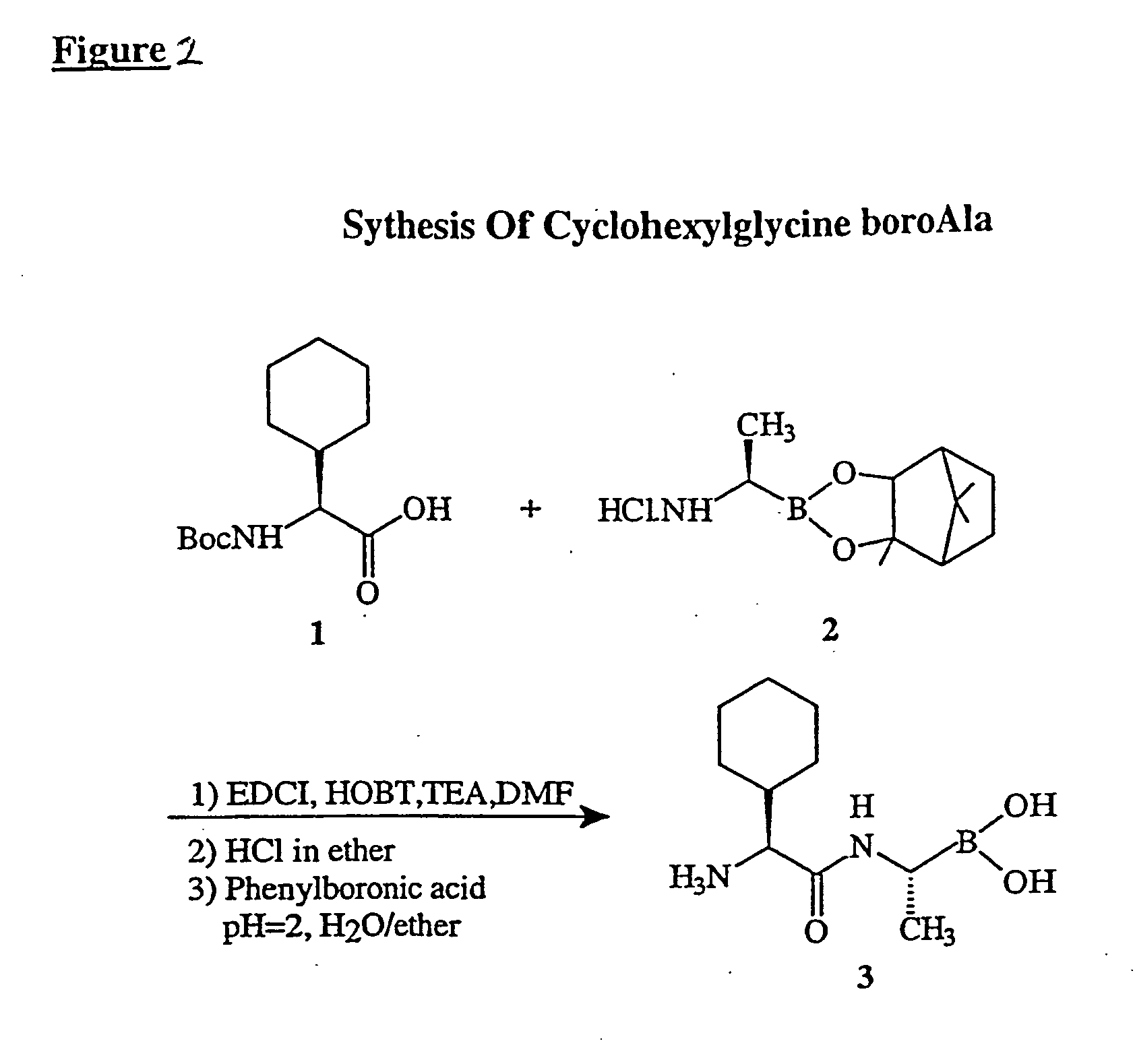Methods for treating autoimmune disorders, and reagents related thereto
a technology for which is applied in the field of methods for treating autoimmune disorders and reagents related thereto, and can solve problems such as the potential for producing hypoglycemia, the increase of insulin deficiencies, and the further damage of cells
- Summary
- Abstract
- Description
- Claims
- Application Information
AI Technical Summary
Benefits of technology
Problems solved by technology
Method used
Image
Examples
example 1
Synthesis of BoroProline
Referring to FIG. 1, the starting compound I is prepared essentially by the procedure of Matteson et al. (Organometallics 3:1284, 1984), except that a pinacol ester is substituted for the pinanediol ester. Similar compounds such as boropipecolic acid and 2-azetodine boronic acid can be prepared by making the appropriate selection of starting material to yield the pentyl and propyl analogs of compound I. Further, Cl can be substituted for Br in the formula, and other diol protecting groups can be substituted for pinacol in the formula, e.g., 2,3-butanediol and alphapinanediol.
Compound II is prepared by reacting compound I with [(CH3)O3Si]2N—Li+. In this reaction hexamethyldisilazane is dissolved in tetrahydrofuran and an equivalent of n-butyllithium added at −78° C. After warming to room temperature (20° C.) and cooling to −78° C., an equivalent of compound I is added in tetrahydrofuran. The mixture is allowed to slowly come to room temperature and to stir...
example 2
Preparation of BoroProline-Pinacol
The intermediate, 4-Bromo-1-chlorobutyl boronate pinacol, was prepared by the method in Matteson et al. (Organometallics 3:1284, 1984) except that conditions were modified for large scale preparations and pinacol was substituted for the pinanediol protecting group.
3-bromopropyl boronate pinacol was prepared by hydrogenboronation of allyl bromide (173 ml, 2.00 moles) with catechol borane (240 ml, 2.00 moles). Catechol borane was added to allyl bromide and the reaction heated for 4 hours at 100° C. under a nitrogen atmosphere. The product, 3-bromopropyl boronate catechol (bp 95-102° C., 0.25 mm), was isolated in a yield of 49% by distillation. The catechol ester (124 g, 0.52 moles) was transesterified with pinacol (61.5 g, 0.52 moles) by mixing the component in 50 ml of THF and allowing them to stir for 0.5 hours at 0° C. and 0.5 hours at room temperature. Solvent was removed by evaporation and 250 ml of hexane added. Catechol was removed as a cry...
example 3
Synthesis of BoroProline Peptides
General methods of coupling of N-protected peptides and amino acids with suitable side-chain protecting groups to H-boroProline-pinacol are applicable. When needed, side-chain protecting and N-terminal protecting groups can be removed by treatment with anhydrous HCl, HBr, trifluoroacetic acid, or by catalytic hydrogenation. These procedures are known to those skilled in the art of peptide synthesis.
The mixed anhydride procedure of Anderson et al. (J. Am. Chem. Soc. 89:5012, 1984) is preferred for peptide coupling. Referring again to FIG. 1, the mixed anhydride of an N-protected amino acid or a peptide is prepared by dissolving the peptide in tetrahydrofuran and adding one equivalent of N-methylmorpholine. The solution is cooled to −20° C. and an equivalent of isobutyl chloroformate is added. After 5 minutes, this mixture and one equivalent of triethylamine (or other sterically hindered base) are added to a solution of H-boroPro-pinacol dissolved ...
PUM
| Property | Measurement | Unit |
|---|---|---|
| Structure | aaaaa | aaaaa |
| Molecular weight | aaaaa | aaaaa |
| Hydrophobicity | aaaaa | aaaaa |
Abstract
Description
Claims
Application Information
 Login to View More
Login to View More - R&D
- Intellectual Property
- Life Sciences
- Materials
- Tech Scout
- Unparalleled Data Quality
- Higher Quality Content
- 60% Fewer Hallucinations
Browse by: Latest US Patents, China's latest patents, Technical Efficacy Thesaurus, Application Domain, Technology Topic, Popular Technical Reports.
© 2025 PatSnap. All rights reserved.Legal|Privacy policy|Modern Slavery Act Transparency Statement|Sitemap|About US| Contact US: help@patsnap.com



